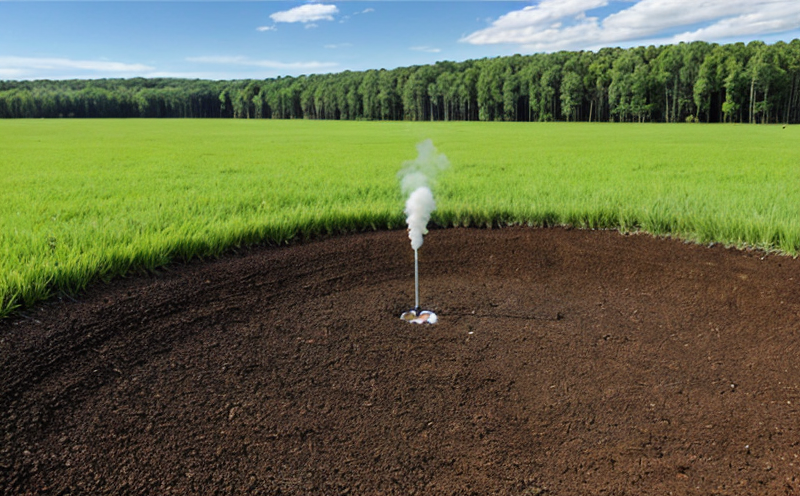OEC 209 Activated Sludge Respiration Inhibition in Mining Wastewaters
The OECD 209 test method is a critical tool used to assess the impact of mining wastewaters on activated sludge respiration. This test evaluates the toxicity of wastewater effluents by measuring their effect on the respiration rate of activated sludge, which acts as a model for biological treatment processes in sewage systems and water treatment plants.
This methodology is particularly relevant to the mining sector due to the presence of heavy metals, organic compounds, and other pollutants that can be detrimental to aquatic ecosystems. By conducting this test, environmental managers and compliance officers can ensure that their wastewater discharges meet regulatory standards set by bodies like the Environmental Protection Agency (EPA) or Environment Canada.
The OECD 209 protocol involves exposing activated sludge from a sewage system or treatment plant to the mining wastewater under controlled conditions. The respiration rate is then measured before and after exposure to determine if there has been any inhibition due to the presence of contaminants in the wastewater. This test provides valuable insights into the biodegradable nature of pollutants in the wastewater, helping to prevent potential environmental harm.
Compliance officers can use this information to adjust their processes or implement remediation strategies to minimize negative impacts on receiving waters. R&D engineers may leverage these findings for developing new treatment technologies or refining existing ones to enhance the efficiency and effectiveness of biological treatment systems.
The OECD 209 test is conducted in accordance with ISO standards, ensuring consistent and reliable results across different laboratories. The test apparatus typically includes an incubation chamber where the activated sludge samples are exposed to varying concentrations of mining wastewater. Precise control over temperature, pH, and other parameters ensures accurate measurement of respiration rates.
The OECD 209 method is widely recognized for its robustness in assessing the potential ecological risks posed by mining effluents. It plays a crucial role in supporting regulatory compliance, environmental stewardship, and sustainable development within the mining industry. By adhering to this standard, operators can demonstrate their commitment to protecting aquatic ecosystems while ensuring operational efficiency.
Understanding the nuances of this test is essential for those involved in environmental management, particularly in sectors like mining where stringent regulations govern wastewater discharge practices. Familiarity with this methodology equips stakeholders with the knowledge necessary to navigate complex regulatory landscapes and contribute positively towards sustainable development goals.
| Parameter | Description |
|---|---|
| Sample Type | Activated Sludge from Sewage System or Treatment Plant |
| Exposure Time | 24 hours at 20°C ±1°C |
| Initial Respiration Rate | Maintained above 80% of control values |
| Final Respiration Rate | Measured after exposure to determine inhibition percentage |
Applied Standards
The OECD 209 test method is standardized in accordance with ISO and other international standards. These guidelines ensure that all testing procedures are consistent, reproducible, and accurate across different laboratories.
- ISO 11348-2 - Guidelines for the determination of biodegradability by means of respiration tests using activated sludge
- OECD Guideline for Testing of Chemicals No. 209 - Respiration Inhibition Test with Activated Sludge
The use of these standards guarantees that the results obtained from this test are reliable and internationally recognized, facilitating easier compliance with relevant regulations.
Benefits
- Regulatory Compliance: Ensures adherence to environmental protection laws and guidelines.
- Risk Assessment: Identifies potential risks associated with wastewater discharge into natural water bodies.
- Treatment Optimization: Helps in optimizing treatment processes to achieve better pollutant removal efficiency.
- Data Validation: Provides scientific evidence supporting decisions related to environmental management practices.
The OECD 209 test offers significant advantages by providing comprehensive data that supports informed decision-making regarding wastewater management strategies. This ensures not only compliance with legal requirements but also promotes responsible stewardship of natural resources.
Industry Applications
| Application Area | Description |
|---|---|
| Mining Industry | Evaluating the toxicity and biodegradability of mine tailings and process water. |
| Agricultural Sector | Assessing the impact of agricultural runoff on local ecosystems. |
| Industrial Parks | Determining the suitability of discharged industrial effluents for reuse or discharge into public systems. |
| Water Treatment Plants | Monitoring and adjusting treatment processes to meet stringent regulatory requirements. |
The OECD 209 test has broad applicability across various industries, making it an invaluable tool for assessing the environmental impact of industrial activities. Its versatility allows for tailored applications depending on specific industry needs.





